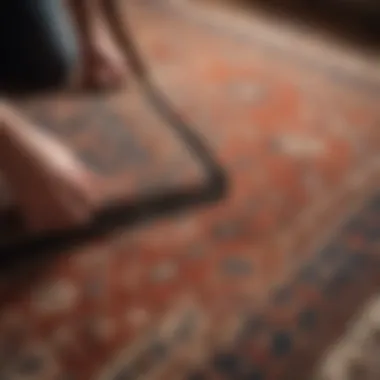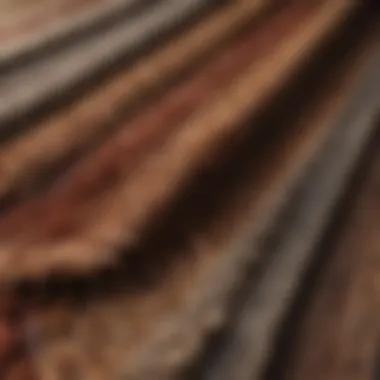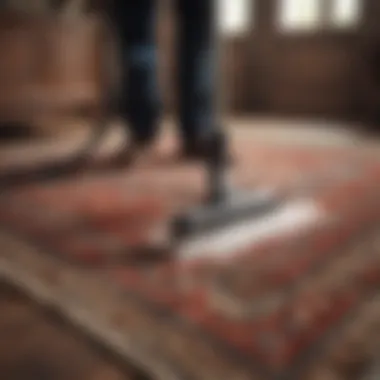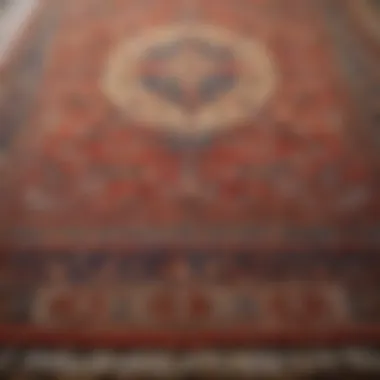Comprehensive Guide to Cleaning Old Rugs


Intro
Cleaning old rugs is a task that goes beyond mere aesthetics. It is a commitment to preserving history, culture, and craftsmanship embedded in every fiber. Homeowners and design enthusiasts often overlook the significance of proper cleaning techniques, which can either enhance or detract from the beauty of these distinctive pieces. This guide serves to unravel the complexities surrounding the cleaning of old rugs, providing clear and actionable insights to help maintain their structural integrity and visual appeal.
From understanding the materials used in construction to the various cleaning methods available, every aspect plays a crucial role in the rug’s longevity. The aim here is to offer a comprehensive understanding of each step, ensuring that both novices and experienced caretakers can appreciate and apply the knowledge shared. By comprehending the intricacies of rug cleaning, one can effectively preserve the unique characteristics that make these items such coveted elements in interior spaces.
Prelude to Rug Maintenance
Maintaining old rugs is crucial not only for preserving their visual appeal but also for ensuring their longevity. Rugs often carry significant aesthetic and emotional value. They can define a room's character and create a sense of home. Thus, proper maintenance becomes imperative to prolong their life and uphold their beauty.
Cleaning old rugs holds immense importance. Accumulated dust, grime, and stains can lead to deterioration. Regular cleaning minimizes these issues, enhancing the rug’s lifespan. Additionally, it prevents allergens and pollutants from impacting indoor air quality.
The process of maintaining rugs involves various steps, beginning with a thorough understanding of their materials. For example, the care needed for a wool rug differs significantly from that required for synthetics. Each type has its unique properties and vulnerabilities.
Despite their importance, rug maintenance poses certain challenges. Homeowners often face difficulties in identifying cleaning methods that do not damage the fabric. Moreover, irregular cleaning schedules can lead to more severe issues over time. A well-maintained rug is not just aesthetically pleasing; it also reflects the care taken by its owner.
In this guide, we will delve deeper into these aspects of rug maintenance, addressing the necessity of cleaning old rugs and the common challenges faced during this upkeep. Through practical advice and insights, we aim to equip readers with knowledge to maintain their treasured rugs effectively.
Understanding Different Rug Materials
In the realm of rug cleaning and maintenance, understanding the different materials used in rugs is crucial. Each type of material requires distinct approaches to cleaning, care, and preservation. Ignoring the characteristics of the fibers can lead to irreversible damage or reduced longevity of the rug. By recognizing the properties of natural fibers like wool and cotton versus synthetic options such as nylon and polyester, homeowners can make informed decisions about maintenance routines. This knowledge ultimately enhances the aesthetic and structural integrity of the rugs, ensuring that they remain beautiful and functional for years to come.
Natural Fibers: Wool and Cotton
Natural fibers, particularly wool and cotton, have been favored for centuries due to their durability and aesthetic appeal. Wool, for instance, is renowned for its resilience, natural stain resistance, and ability to regulate temperature, making it an excellent choice for rugs. When cleaning wool rugs, it's essential to use mild detergents and avoid soaking them, as excessive moisture can deform the fibers.
Cotton, while less durable than wool, is more affordable and easy to clean. It absorbs dyes well, allowing for vibrant patterns. However, cotton is also more prone to staining, so timely cleaning is paramount. Regular vacuuming is recommended for both materials to remove dirt and prevent fiber breakdown over time.
"Natural fibers provide not only a rich texture but also a timeless elegance to any space."
Synthetic Fibers: Nylon and Polyester
Synthetic fibers such as nylon and polyester have gained popularity due to their affordability and stain resistance. Nylon is especially durable, making it suitable for high-traffic areas. Its resistance to fading and mold growth enhances its longevity. When cleaning nylon rugs, using hot water extraction methods can be effective.
Polyester, on the other hand, is recognized for its vibrant color retention and soil-repelling properties. However, it can be less durable compared to nylon. Proper cleaning involves using commercially available cleaning products designed for polyester. Regular vacuuming remains critical to maintain the appearance and prolong the life of rugs made from synthetic fibers.
Understanding Hand-Woven and Machine-Made Rugs
The crafting method also significantly influences rug cleaning methods. Hand-woven rugs, often made from natural fibers, carry unique qualities such as intricate designs and varied textures. Cleaning these rugs requires a gentle hand to preserve their craftsmanship.
Machine-made rugs, frequently made from synthetic materials, tend to be easier to clean due to their uniform structure. Routine maintenance often involves straightforward techniques such as vacuuming and spot cleaning. However, it is still important to inspect for any signs of wear to address issues before they escalate.
By understanding the nuances of different rug materials, homeowners can adopt more effective and tailored cleaning methods. This knowledge helps to protect the integrity and beauty of their rugs, enhancing both their longevity and aesthetic appeal.
Assessing the Condition of Your Rug
Understanding the condition of your rug is essential before embarking on any cleaning or maintenance process. Evaluating your rug's current state allows you to tailor your approach to preserve its longevity and appearance. This assessment not only helps in identifying specific issues, but it also guides you in making informed decisions about cleaning methods and potential repairs. Properly assessing the condition ensures that you avoid causing more harm than good during cleaning, especially with older rugs that may be more fragile.
Identifying Stains and Damage
Start the assessment by closely examining your rug for stains and visible damage. Look for discoloration, faded areas, and any signs of wear, such as fraying edges or loose threads. Stains can be caused by various substances, like food, pet accidents, or even dye transfer from furniture. Each type of stain may require a different cleaning approach.
Additionally, check for structural problems. These may include pulls in the fibers or sections that are thinning significantly. Look at the underside of the rug for any signs of mold or mildew, as these can be hidden but severely affect the rug’s integrity.
Evaluating Fiber Integrity


The fiber composition of your rug plays a major role in its resilience and how it reacts to cleaning. To evaluate fiber integrity, gently tug on the fibers in various areas. Healthy strands should remain firm, while overly soft or brittle spots may indicate damage. If the rug contains natural fibers like wool, consider checking them for signs of moth damage or other pest-related issues. Synthetic fibers like nylon are typically more durable but may show different types of wear.
Before any deep cleaning, it’s crucial to know whether the fibers are intact or compromised. If they're damaged, excessive cleaning could worsen the condition. This will aid not only in choosing the right cleaning method but also in determining if professional assistance is necessary.
Consulting Professional Evaluators
In some cases, particularly with valuable or antique rugs, it may be wise to consult a professional evaluator. Experts can provide a detailed analysis of your rug, assessing both visible and hidden damages. They offer insights into the best cleaning methods, required repairs, and potential preservation techniques.
Finding the right professional can save time and possible further damage. Look for services with good reviews or recommendations. Utilize platforms like reddit.com or local community forums to gauge user experiences with different services.
By accurately assessing your rug's condition, you set the stage for effective cleaning and long-term care. This understanding allows you to create a tailored maintenance plan that preserves the beauty and integrity of your rug for years to come.
Pre-Cleaning Preparation
Pre-cleaning preparation is an essential phase in the process of cleaning old rugs. It sets the right foundation for effective cleaning and helps protect the rug from potential damage. By taking the time to prepare properly, the cleaning process can become more efficient. Furthermore, this preparation phase can identify any specific needs or issues with the rugs, ensuring a tailored cleaning approach.
Removing Furniture and Accessories
Before any cleaning begins, removing furniture and accessories from the rug area is critical. This step not only clears the space but also protects the items from damage during the cleaning process. Heavy furniture can cause indentations, while smaller items can become lost or stained.
To safely remove furniture:
- Lift, don’t drag: Care should be taken not to pull heavy items across the rug, as it may cause fibers to fray.
- Use furniture coasters: When shifting items back into place, coasters can help reduce pressure on the rug.
Ensuring the area is clear will allow for a comprehensive cleaning effort.
Vacuuming Techniques for Rugs
Vacuuming is often the first line of defense in maintaining old rugs. Using proper techniques can significantly enhance the effectiveness of cleaning.
- Adjust the settings: Use the appropriate suction settings to avoid pulling fibers from the rug.
- Direction matters: Always vacuum in the direction of the pile for best results.
- Be thorough: Pay attention to edges and corners where dirt can accumulate, as these areas often require extra attention.
Vacuuming regularly helps preserve the integrity of the fibers, preventing dirt buildup that can lead to more serious issues.
Testing for Colorfastness
Testing for colorfastness is vital before applying any cleaning solution. This step helps ensure that the colors in the rug will not bleed or run during the cleaning process. To test for colorfastness:
- Choose a hidden area: Find a spot that is not easily visible, like beneath a furniture leg.
- Dampen a white cloth: Using plain water, dampen a white cloth without soaking it.
- Blot gently: Press the damp cloth on the test area and check for any color that transfers to the cloth.
If there is no transfer, it implies that the colors are stable. If there is a transfer, it may necessitate the use of specialized cleaning methods or products.
Proper pre-cleaning preparation can greatly enhance the results of the rug cleaning process. Taking the necessary steps ensures a safer and more effective cleaning experience.
Cleaning Methods for Old Rugs
Cleaning old rugs requires thoughtful consideration of the materials and construction to maintain their quality and appearance. Choosing the right cleaning method not only preserves the aesthetic appeal but also prolongs the lifespan of the rug. Due to the variety of materials and construction techniques, it is critical to understand which method is best suited for your specific rug type. This section details various cleaning techniques to ensure your rugs remain beautiful and intact.
Dry Cleaning Techniques
Dry cleaning is an effective method for certain rug types, particularly those made of delicate fibers that may be damaged by water. This method employs chemical solvents instead of water, minimizing the risk of shrinkage and color bleeding. Commonly used materials include synthetic powdered cleansers and specialized dry cleaning solutions.
The steps for a successful dry cleaning process typically include:
- Vacuum the rug thoroughly. This removes dust and dirt from surface fibers.
- Apply the dry cleaning powder. Evenly distribute it across the rug’s surface, allowing it to absorb dirt.
- Agitate gently. Use a soft brush to work the powder into the fibers without damaging them.
- Let the powder sit. This step typically lasts up to 30 minutes to maximize dirt absorption.
- Vacuum again. Ensure all the powder and dirt are completely removed.
For particular stains or spills, targeted stain removers can enhance effectiveness, yet it’s crucial to conduct a patch test to avoid damage.


Wet Cleaning Approaches
Wet cleaning, while effective, comes with risks associated with moisture retention in rugs. This method is most suitable for rugs crafted from sturdy materials like wool and cotton, which can withstand water exposure. Proper execution is paramount to avoid issues such as mold growth or color fading.
Steps to consider during wet cleaning include:
- Properly assess the rug’s conditions to ensure it can tolerate moisture.
- Prepare a cleaning solution. This often includes gentle detergents mixed with water. Avoid harsh chemicals as they can cause damage.
- Test for colorfastness. Apply the solution to a small area to verify that colors remain unchanged.
- Clean with a soft brush or cloth. Work the solution into the fibers, paying attention to stained areas.
- Rinse thoroughly. Remove any soap residues and gently blot the rug to eliminate excess water.
- Air dry completely. Place the rug in a well-ventilated area and avoid direct sunlight to prevent fading.
It's important to note that moisture can be harmful. Always ensure the rug is completely dry before placing any furniture back on it to prevent mildew.
Using Professional Cleaning Services
For certain rugs, especially vintage or antique pieces, seeking professional cleaning services might be the best course of action. These experts are trained to handle various materials and intrinsic values of old rugs. They utilize advanced tools and techniques that ensure your rug receives the best care possible without the risk of damage.
Key aspects to consider when engaging professionals include:
- Research and reviews. Look for companies with strong reputations and positive feedback from previous clients.
- Ask about their methods. Ensure they use appropriate cleaning techniques suited for your rug type.
- Inquire about insurance. This will provide you with security in case any damage occurs during the cleaning process.
- Request a written estimate. Clear costs can facilitate informed decisions without hidden fees.
Post-Cleaning Care and Maintenance
Maintaining an old rug after cleaning is essential to ensure its longevity. Proper post-cleaning care can greatly influence the rug's aesthetic and structural integrity. Once the cleaning process is complete, what you do next is just as significant as the cleaning techniques employed. This section focuses on key aspects of post-cleaning care and how they contribute to preserving your beautiful rugs.
Drying Procedures for Rugs
Drying the rug correctly is a critical step after cleaning. It is important to avoid any dampness that can lead to mold or mildew. Here are a few effective guidelines for drying:
- Air Drying: Hang the rug in a well-ventilated area. This method is gentle and helps prevent any potential damage that may arise from excess heat.
- Avoid Direct Sunlight: While sunlight can be helpful for drying, prolonged exposure can cause fading of colors. Find a shaded location that receives good airflow.
- Flip the Rug: Once one side is dry, flipping it allows both sides to dry evenly. This step helps maintain the rug's flatness.
- Dehumidifiers or Fans: If moisture is excessive in the room, using a dehumidifier or fan can speed up the drying process effectively.
Implementing these steps will help to ensure that your rug does not retain moisture.
Assessing the Aftercare Needs
After proper drying, it’s essential to assess the rug's aftercare needs. Each rug will have unique requirements based on its material and condition:
- Vacuuming: Regularly vacuum the rug to remove dust and dirt. This prevents buildup that can affect the rug's fibers over time.
- Spot Cleaning: Occasionally inspect for stains or spills. Addressing them immediately helps prevent long-term damage.
- Professional Evaluation: Depending on the rug's condition post-cleaning, it may be necessary to consult with a professional to determine if additional interventions are needed.
"Regular aftercare maximizes the lifespan of your rug and keeps it looking its best."
Following these practices allows you to maintain your rug in excellent condition.
Rearranging Furniture Thoughtfully
Once your rug is clean and dried, it’s important to return furniture thoughtfully. The positioning of furniture can impact the rug's appearance and health:
- Weight Distribution: Avoid placing heavy furniture directly on the rug to prevent flattening the fibers. Use coasters or pads to distribute weight more evenly.
- Spacing: Allow some space between the rug and furniture edges. This not only highlights the rug but also protects the edges from wear.
- Periodic Reshuffling: Regularly move furniture to avoid creating permanent indentations in the rug. Even slight adjustments can help refresh the look and prolong its life.
Long-term Rug Preservation Strategies
Maintaining the quality and appearance of old rugs demands more than regular cleaning; it also involves implementing long-term preservation strategies. These strategies are essential for extending the life of your rug while safeguarding its unique textures and colors. A well-preserved rug enhances the overall aesthetics of your space and serves as a testament to your attention to detail in home maintenance.
Regular Maintenance Routines
Establishing a regular maintenance routine is crucial for preserving your rug. Frequent attention not only prevents dirt and debris accumulation but also helps in identifying issues early. Regular vacuuming is one of the simplest and most effective methods. Aim to vacuum at least once a week, using a vacuum cleaner that has adjustable height settings. This helps avoid damage to the rug fibers.
Moreover, you should consider spot cleaning any stains immediately, rather than waiting for a scheduled cleaning session. A solution of mild soap and water works well for most stains, but always test it on a non-visible area first. It's also helpful to rotate your rug periodically to ensure even wear, especially in high-traffic areas.


Proper Storage Techniques
When it comes to storing rugs, there are specific steps that are necessary to safeguard their integrity. If you need to store a rug for an extended period, first clean it thoroughly to remove any dirt or stains. Proper drying is essential, as moisture can promote mold and mildew growth.
When rolling the rug, always roll it with the pile facing inward to protect the fibers. Use breathable materials like cotton or muslin to wrap the rug, avoiding plastic, which can trap moisture. Storing in a cool, dry location away from direct sunlight will prevent fading and degradation of colors over time.
Utilizing Protective Products
In order to enhance the longevity of your rug, consider utilizing protective products designed specifically for rugs. These can include stain repellents that are effective at preventing liquid spills from soaking into the fibers. Applying a protective spray may help keep your rugs looking new and vibrant.
Additionally, using area rugs pads can provide cushioning and reduce wear over time. These pads can help keep the rug in place, preventing slips and falls, while also adding an extra layer of protection against dirt and grit that can be ground into the fibers.
Ultimately, investing in the right protective solutions is a proactive approach to rug care. It pays to prioritize these strategies for preserving the beauty and function of your rugs for years to come.
Implementing these long-term rug preservation strategies significantly contributes to maintaining both the appearance and value of your rugs. A combination of routine maintenance, appropriate storage, and protective measures will not only prolong the life of your rugs, but it will also enhance your living environment.
When to Seek Professional Help
Cleaning old rugs can be a meticulous task, often leading homeowners to wonder if certain situations may require professional intervention. While many cleaning tasks can be managed by individuals, certain aspects of rug care necessitate the expertise of trained professionals. Understanding when to ask for help can save you time, enhance the rug's longevity, and prevent further damage.
In this section, we will explore the critical signs indicating that professional help is needed. We will also discuss how to choose a reputable cleaning service. Identifying issues early allows for appropriate action, ensuring that your old rugs are preserved effectively and maintained in their best possible condition.
Signs That Indicate Professional Intervention
There are several indicators suggesting that a rug may need professional cleaning rather than DIY methods. Key signs include:
- Severe Stains: Persistent stains from wine, pet accidents, or heavy traffic cannot be removed with standard cleaning products.
- Fraying Edges: Edges that are fraying or show signs of unraveling may require a specialist's attention to prevent further damage.
- Mold or Mildew: If your rug has developed a musty smell or visible mold, it��’s essential to consult professionals who understand how to treat it safely and effectively.
- Excessive Wear: For antiques or valuable rugs, wear may be so extensive that only a skilled rug restorative can maintain their integrity.
- Flat or Mottled Pile: A significant dulling of color or flattened areas indicates that the rug has lost its pile. Restoration methods by experts can help revitalize it.
Failing to address these signs can lead to irreversible damage and increased costs in restoration. Thus, if you notice any concerning issues, do not hesitate to reach out to a rug cleaning professional.
Choosing a Reputable Cleaning Service
Selecting the right cleaning service is crucial for the preservation of your rug. Not all cleaning services have the expertise, so careful consideration is needed. Here are steps to help you choose wisely:
- Research: Look for reviews and ratings on platforms such as Facebook or Reddit. Recommendations from community members can provide insight into local services.
- Experience: Ensure the company has extensive experience, particularly with the type of rug you own. Some services specialize in certain materials, such as Persian or Tibetan rugs.
- Certifications: Check if the cleaners are certified by organizations like the Institute of Inspection, Cleaning and Restoration Certification (IICRC).
- Methods Used: Inquire about the cleaning methods they use. Ensure they employ safe practices suitable for your rug's material.
- Estimates: Always request a detailed quote before work begins, ensuring you understand what services are included.
Choosing a reputable cleaning service can protect your investment and ensure your old rug remains beautiful and functional for years to come.
Remember, taking proactive steps can greatly enhance the lifespan of your rugs and reduce the need for costly repairs later.
End
Cleaning old rugs is a fundamental practice that safeguards both their aesthetic appeal and structural integrity. This comprehensive guide highlights several essential strategies that homeowners and design enthusiasts can implement. It is critical to understand the various materials, from wool to synthetic fibers, as this knowledge guides the selection of appropriate cleaning methods.
Maintaining old rugs not only enhances their longevity but also helps preserve historical or sentimental value. Regular assessments of rug condition and appropriate maintenance routines foster a deeper connection with one’s interior space.
The benefits of these practices extend beyond mere appearance; they contribute to a healthier indoor environment by reducing allergens and dust. Prospective buyers and homeowners alike will find that clean, well-maintained rugs can enhance property value. An investment in the care of old rugs can yield significant returns over time.
Recap of Effective Cleaning Strategies
To encapsulate the most effective cleaning strategies discussed:
- Routine Maintenance: Regular vacuuming is essential to remove dust and particles that can degrade fibers over time.
- Identify and Treat Stains Promptly: Immediate attention to stains minimizes damage and prevents permanent discoloration.
- Choose Appropriate Cleaning Methods: Consider both dry-cleaning and wet-cleaning techniques based on the rug’s material.
- Professional Help When Needed: Enlisting experts for significant repairs ensures the longevity of valuable rugs.
By employing these strategies, you can maintain your old rugs' beauty and functionality effectively.
Encouragement for Ongoing Care
It is important to view rug maintenance as an ongoing commitment rather than a one-time task. Incorporating these cleaning and care practices into your regular household routines will yield significant benefits.
- Set a Schedule: Establish a cleaning schedule that includes vacuuming and professional cleanings at least once a year.
- Keep an Eye on Changes: Regularly inspect your rugs for signs of wear or damage.
- Educate Yourself: Learn more about the materials and care methods tailored to your specific rugs.
By dedicating a bit of time and attention to care, the ongoing beauty and integrity of your rugs will be assured. Properly maintained rugs not only elevate the ambiance of a space but also reflect your commitment to preserving your investment.







